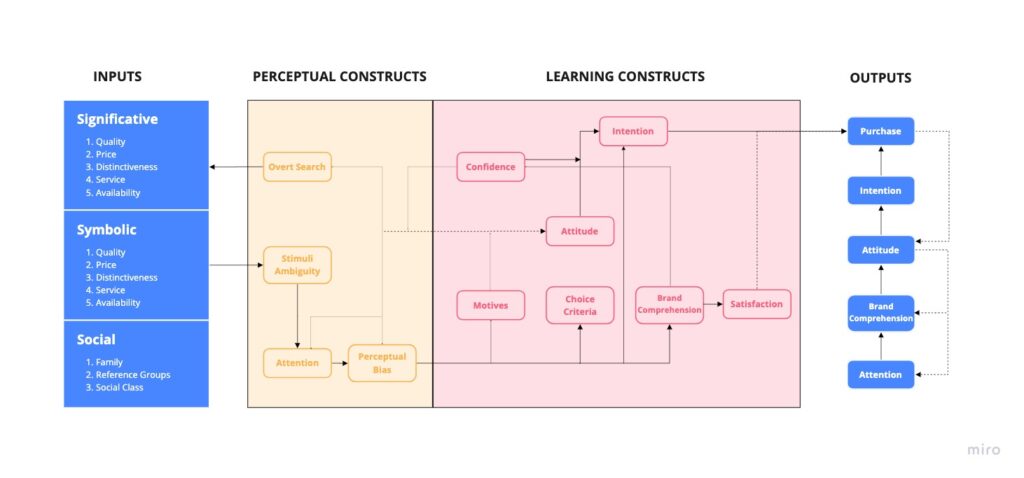Introduction
In our society, consumer behavior is a topic of extreme importance. In fact, understanding buyer behavior is considered to be one of the most important tasks of marketers. To understand this topic in detail, let’s look at how Howard Sheth’s model can help us understand it in great detail. In 1969, John Howard and Jagadish Sheth published a book called ‘The Theory Of Buyer Behavior’ which describes how people make buy decisions when they shop for products.
What is the Howard-Sheth model of consumer behavior?
The Howard Sheth model of consumer behavior is a sophisticated integration of social, psychological, and marketing influences on consumers’ choices into one coherent sequence. The idea is to make a model of human behavior and how it works in the brain. We want to know what makes people behave like they do when they buy certain things.
The Howard model represents a comprehensive view of human behavior as seen from the perspective of social influence. The model reveals that while social influences can overpower psychological and marketing factors, the power of information technology should not be underestimated either. In other words, convergence is taking place whereby consumers are increasingly status-driven as well as individualistic in their choice behaviors. It builds on these aspects and other insights from psychology, price signaling, choice modeling theory (Janschewitz & Soltau 1997), decision-making research in organizations (Whitley 1982), Kahneman’s framework (Kahneman & Tversky 1974/1979), economic theory, physiology—hence the brain.
What are the four components of the Howard Sheth model?
Inputs, Hypothetical constructs, Outputs, and Exogenous(External) Variables.

Inputs
Input variables signify the stimuli given by the company or through the external environment. The Inputs are further classified into three types of stimuli namely: i) Significative, ii) Symbolic and, iii) Social. The inputs have physical and /or metaphysical meaning.
The Symbolic input signifies a message or a symbol carrying value, e.g., an advertisement in the mass media conveys information about how much one should buy of something to get ahead in life, etc. Significative inputs carry value, but their significance is sensory in nature—in contrast to the former. For example, home decor or art purchase carries the symbolic meaning that relates it to one’s position within the social group. The Social stimuli/input signifies common values and /or norms that are shared among members of a reference group.
The symbolic and the social inputs are categorized as conceptual, whereas significant factors collect data from observable behavioral cues which can be observed by outside social class but are not common to them. Example: A handheld GPS system may be a significant and strong signal to purchase the feature of having a map for your traveling reasons. The symbolic factor of a luxury car can mean, “I am rich and powerful”. On the other hand, you might choose to take public transport because free parking spaces were not enough.
Hypothetical constructs
The most important component of the model tries to explain the decision-making process of the specific consumer. The psychological variables involved can be grouped into i) perceptual constructs and ii) Learning constructs. The whole cycle starts with “perception” where the individual becomes familiar with the product. It culminates into “learning” which reinforces his/her belief about what he has chosen and, therefore, how it will benefit him in the future.
Perceptual Constructs
The perceptional constructs relate to expectations. These are primarily related to brand familiarity, ego strength, and price sensitivity of the target consumers. “Ego strength” is one’s self-confidence in his ability to make good choices about what he buys. The feeling that the decisions are basically made by oneself and that you don’t need any other people to make a decision leads to perceptual bias about the price. In terms of cognitive functioning, stimulus ambiguity happens when the symbolic stimuli sent by the company get muddied by the environment before reaching the intended audience.
Learning Constructs
The learning factors can be divided into features that lead to buying, and lifestyles that are built through the construction of a personal framework. Factors include intention, confidence, attitude, motives, choice criteria, brand comprehension, and satisfaction. Therefore after the interpretation of features, learning processes deal with creating a specific framework for future purchases which include feelings and perceptions toward merchandise(driven by desire) as well as symptoms of satisfaction (and happiness).
Finally, relevance is the last tie to form a decision. This includes variables such as advertising effects on price discrimination. Many studies have shown that promotions are based on customers’ reactions to advertising advertisements through effects of pricing, competitive stimuli, or product-bundle which also depend on consumer information regarding the economic status and age bracket, including that of industrial buyers.
Outputs
From the model, it can be seen that the output variables are not just limited to actual purchase but also shift/change in the intention, attention, or even the attitude towards the brand. For example, customers may also use the brand in non-consummative events. Companies must be very careful when creating advertisements because they can lead to negative effects on consumers’ general attitudes towards businesses/brands, thus leading them to patronize other brands accompanied with similar characteristics.
In a study conducted by Eurobarometer, approximately 61% of French citizens agree that advertisements influence customers’ purchasing decisions as per the issue on “Ads Influence Purchasing Decisions”.
Exogenous Variables
As for the external variables, brands often face unreliable actions such as slowdown or economic downturn which result in an excessive drop in demand. This is mostly because of accurate forecasting and change to purchasing trends but also occurs due to over-explanation through various theories(the information system component). For example, companies could choose to decrease prices in fear of losing customers, which can lead to a price war and/or other economic factors that may adversely affect demand. Additionally, negative news or events such as terrorist incidents and natural disasters also influence consumption.
Factors like religion can also prevent an increase in demand which is due to their socially unacceptable nature-thus lowering the number of consumers who wish to consume it. A study conducted by Dunn and Hallenstein found that advertising with content deemed as morally bad has an actual positive effect on people who encounter it. This indicates that exposure to advertising via negative content can actually increase the number of consumers exposed to advertisements in general, thus making their potential customers more likely to consume goods and services associated with this advertisement(Dunn & Hallenstein 2016).
What are the three levels of the Howard Sheth model?
Extensive Problem Solving
At this level, the consumer doesn’t have any understanding of the products/services and doesn’t have any brand preference. Consumers will need to compare many different products before deciding which one they like best and then purchasing it from that brand only (the consumer is determining if he or she likes this product more than another one).
Limited Problem Solving
As the name suggests the consumer will have a limited understanding of the products. This means there will be a lot of people in the world who won’t be able to make good choices for themselves because they don’t have enough knowledge on their own or on what they need to get from others. In order to arrive at a brand preference, we must know something about other companies and their products before we make up our minds which one is good or not so good for us.
Habitual/Routinized Response Behavior
At this level, the buyer is fully aware of the products being offered by different brands and their strengths, weaknesses, etc. The buyer is able to make up his or her mind very fast since he has gotten used to the products (products are familiar and not scary anymore) so as a result of consuming those products repeatedly. When people become habitual with buying some brands over time they will eventually reach the “high involvement” stage of decision making(where the consumer is fully aware of both product benefits and negative effects they will feel when consuming that specific brands).
He/she is capable of evaluating and comparing the many products available in the market. Here, he decides what product to buy from a list of possible products on offer from various companies involved with making those products available for sale.
Limitations of the Model
The limitations of the theory could be that it does not explicitly define a cause and effect relationship, only correlation. If one is to propose a causal link between consumption and media usage then further investigation can be performed by studying time-series data from lifestyle surveys or market research sources. Another drawback is that in both significant and symbolic stimuli, the model emphasizes material aspects such as price and quality. These things are not applicable in every society and are also not suitable for the majority of marketing strategies.
